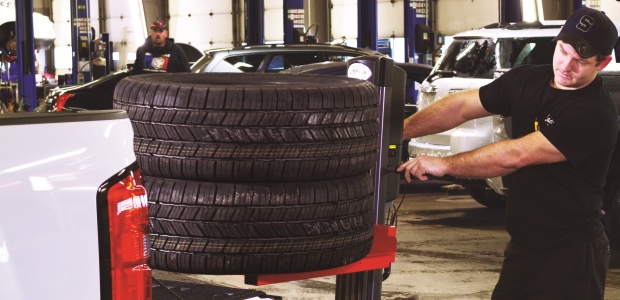
Fork Truck Free and New Materials Handling Innovations
The ergonomic answer to moving heavy items without a fork truck, this innovative approach is designed for ease of use, higher productivity, and keeping workers on the job and free from injuries.
Abraham H. Maslow said, "I suppose it is tempting, if the only tool you have is a hammer, to treat everything as if it were a nail." The tool for 75 years has been the forklift, and materials handling the nail. Neither is true.
Ed Brown (founder of Topper Industrial) is considered the father of the North American fork truck free (FTF) movement. Brown said, "The fork truck free approach will work for any company that operates production lines and processes that are normally fed materials using forklifts; many leading distribution centers are considering driverless options." Safety was the initial driver of the FTF movement with material handling equipment including industrial carts, conveyors, lifts, lifts & tilts, shipping racks, containers, casters, and cart components. Products that keep material moving from the dock to the cart to the assembly line emphasize the importance of ergonomics and safety as top priority.
More than 50 percent of all new distribution centers have a statement requiring that all new lines will be FTF. The need for creative, innovation solutions is in direct proportion with the demands of complexity, kitting, and efficiency while increasing safety, reducing line side inventory, delivering parts accurately, and increasing quality.
Obviously there is no greater concern than the safety, health, and lives of workers. Profits, while very important, are secondary to lives. The notions of safety and profitability are not mutually exclusive. Avoiding costly workers' compensation costs, wrongful death and injury lawsuits, and reducing a wide variety of injury-related costs allow organizations to utilize resources to improve safety, productivity, product quality, and overall business competitiveness.
Forklift Safety Concerns
Training initiatives, meticulously reviewed safety protocols, and reviewed and revised standard operating procedures (SOPs) have not eliminated the dangers that forklifts present to manufacturers. After decades of systematic process improvements in the use of forklift operations in warehouses, distribution centers, and manufacturing plants, many companies, industry leaders, and politicians are concluding that forklift-free environments may be the only fail-proof approach to ensuring safety.
Every year, hundreds of people are killed using forklifts worldwide. Federal OSHA estimates that in the United States alone there are nearly 100 worker fatalities and another 20,000 workers seriously injured in forklift-related incidents annually. OSHA estimates that there are 110,000 forklifts accidents each year and $135 million in immediate costs are incurred due to forklift accidents.
Approximately every three days, someone in the United States is killed in a forklift-related accident; almost 80 percent of forklift accidents involve a pedestrian. One-sixth of all workplace fatalities in the United States are forklift related, 34,000 injuries are treated in emergency rooms every year due to forklift accidents, and 25 percent of all fatalities involving forklifts are due to forklift rollover accidents.
Beyond the serious and very real safety concerns (most critical), there are real costs associated with forklift operations. There are extensive costs for operator training, plant layout restrictions due to forklift aisles, damage to facilities and parts, maintenance, and fuel that can add up quickly. Given these extensive safety considerations, additional cost burdens, and underutilization, there is pressure to aggressively seek alternatives to forklifts that can accomplish the same job (material flow and movement) and that are safer, less expensive, and offer improved utilization.
A critical analysis shows that fork trucks are used in manufacturing cells and areas of distribution centers when far less machinery is needed to move product from point A to point B. Lean manufacturing requires elimination of waste. The big hammer, a forklift, is significant equipment overkill for many tasks. A simple kaizen event found that time spent waiting for a fork truck was easily remedied, however. One of the greatest challenges in the packaging industry, including manufacturing cells, is tool and die set-up. The challenge has been finding a mechanism that would lift the die to the required height without the operator ever having to lift.
Not only is the fork truck too much equipment to handle the task at hand, up to 120 minutes a day waiting for fork trucks are wasted. In materials handling, fast moving consumer goods (FMCG) can be quickly retrieved using an all-in-one lift, transporter, and positioner without a forklift. The workforce multiplier kicks in productivity with no need for special training or licensing (a prerequisite of fork trucks). The ergonomic answer to moving heavy items without a fork truck, this innovative approach is designed for ease of use, higher productivity, and keeping workers on the job and free from injuries. It lifts 350 pounds easily with an all-metal frame platform and a screw-driven lift that delivers smooth precision that hydraulics or chains cannot match.
"This powered product demonstrates the innovation commitment to the manufacturing and materials handling sectors and those customers who requested durable, ergonomic, and quality equipment to allow safe use and transport without wasting time waiting for forklifts," said Andrea Horner, Magline's vice president of marketing.
(The photo used in this article is © Magline LiftPlus.)
This article originally appeared in the October 2016 issue of Occupational Health & Safety.